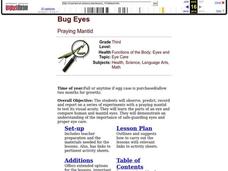Curated OER
Something's Fishy!
Students experience center activities to explore the habits and traits of fish. They observe a goldfish, play a memory game, complete artwork and read about fish.
Curated OER
Soak it up
Students complete a hands on activity using hard boiled eggs, food coloring, tape, cups, water, and a knife to show how permeability affects animals. In this permeability lesson plan, students complete this activity and learn how...
Curated OER
Bug Eyes
Third graders observe, predict, record and report on a series of experiments with a praying mantid to test its visual acuity. They study the parts of an eye and compare human and mantid eyes.
Curated OER
Caterpillars To Butterflies
Students observe the life cycle of a butterfly. They read butterfly/caterpillar themed books. They sequence the lifecycle from eggs on a leaf to an adult butterfly. They release their butterflies into a natural habitat after singing and...
Curated OER
Where are the Dinosaurs?
Young scholars construct their own diorama based on the life of a dinosaur. In this dinosaur lesson, students create models of dinosaurs and dinosaurs' eggs to explore the life cycle of this extinct species.
Curated OER
Recycling
Students study recycling. Group members conduct an experiment by making recycled paper over a four day period. If possible, your class will also take an excursion to a local recycling center.
Curated OER
Osmosis and the Cell Membrane-part 2
Young scholars participate in a review of diffusion and the basic properties of the cell membrane before exploring the process of osmosis in a lab activity. Using shell-less eggs that have soaked in various solutions, students make...
Curated OER
Honu Survivor The Green Sea Turtle Experience
Discuss prior knowledge of the green sea turtle. Young scholars play a game where they are divided into two teams, predators and baby turtles. They receive "name" tags to tell which animal they are. The goal of the baby turtle is to get...
Curated OER
Food Forensics: A Case of Mistaken Identity
Learners develop an experiment to test a hypothesis. They use their knowledge of antigen-antibody specificity to develop a hypothesis. Students articulate that the antibody-antigen specificity is one part of the immune system. They...
Curated OER
It's a Crash Test, Dummy
Students use the internet to research air bags in cars and trucks. In groups, they discover air bags history and the safety issues surrounding them. They create their own design of a new air bag and test it using a raw egg in...
Curated OER
Taking Care of Your Teeth
First graders discuss the importance of taking care of their teeth while viewing pictures showing good/poor teeth care. In this health and science lesson, 1st graders list 3 things to do to keep teeth healthy, creating a lis on chart...
Curated OER
What Class Are You In?
Classifying animals has never been this much fun! Pupils discuss the animal groups, fish, reptiles, amphibians, mammals, birds, and also identify their characteristics. Then, they take pictures of animals and classify them in a group...
Curated OER
Geometry and Measurement
Young geometers explore relationships between units of measure and objects. Three activities provide varied opportunities to practice. Learners calculate the volume of two cylinders made by rolling a piece of paper vertically and...
Curated OER
Hatching Brine Shrimp
Students experiment with temperature and salinity to detect favorable environments for hatching brine shrimp eggs. They make some predictions about which environments will yield the most hatched brine shrimp and record the number of...
Curated OER
How Hot is Too Hot?
Fifth graders use the scientific method to conduct experiments on the temperature effects on organisms. In this temperature effects on organisms lesson plan, 5th graders observe and record the hatching or the developing of organisms into...
Curated OER
Density
Second graders watch a demonstration and complete an experiment to determine how an objects' density allows it to float or sink. They work in small groups to assimilate the characteristics of items that float as opposed to simply...
Curated OER
Osmosis
Second graders discover the process of osmosis. In this science lesson plan, 2nd graders learn how different kinds of solutions move through selectively permeable membranes, understand the role of osmosis in the movement of molecules,...
Curated OER
The Weight of Water
Students examine how salt water is more dense than fresh water. They discuss how manatees need to float and sink, conduct a sink or float experiment, and conduct an experiment with eggs and salt and fresh water.
Curated OER
Chemical Changes
Second graders investigate chemical changes and reactions and will identify four characteristics that indicate a chemical change. In this chemical change lesson plan, 2nd graders perform experiments that promote chemical changes. They...
Curated OER
Hatching Chickens
Young scholars learn the importance of caring for eggs as they hatch chickens. In this egg hatching lesson plan, students observe what happens when eggs are hatched into chickens by completing a e-worksheet and watching a web based movie.
Curated OER
Breaking Color Barriers
Students compare brown eggs and white eggs. In this color lesson, students see two different color eggs and predict what they will look like on the inside. They see that both eggs are the same and compare this to people of different...
Curated OER
EggCELLent Diffusion
Students examine and discuss the concepts of diffusion and osmosis. They observe the effects of diffusion on eggs by recording the change in an egg's size and the amount of liquid substance that remains.
Curated OER
Land Safely...
Students model the preparation needed for a soft-landing on a planet or object in space. They do this by packaging a raw egg with certain material, and dropping the egg from a given height to test the packaging effectiveness.
Curated OER
Salinity
Learners define and discuss salinity, conduct classroom experiment to determine salinity of water sample by using hydrometer, record predictions, and demonstrate understanding of how salinity influences object's ability to float in water.























